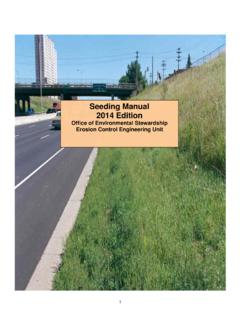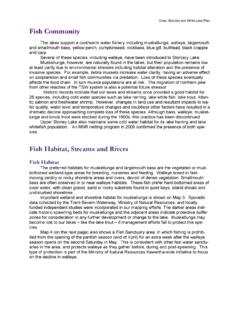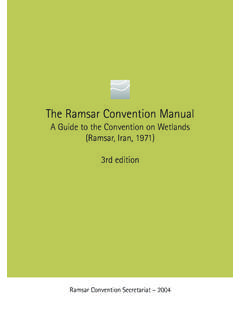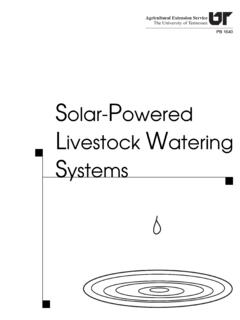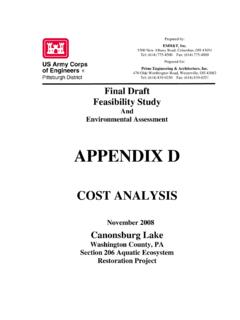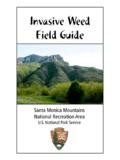Transcription of CHAPTER 7: Management Measures for Wetlands, …
1 CHAPTER 7: Management Measures for Wetlands, riparian Areas, and vegetated treatment Systems I. INTRODUCTION A. What " Management Measures " Are This CHAPTER specifies Management Measures to protect and restore wetlands and riparian areas to protect coastal waters from coastal nonpoint pollution. " Management Measures " are defined in section 6217 of the Coastal Zone Act Reauthorization Amendments of 1990 (CZARA) as economically achievable Measures to control the addition of pollutants to our coastal waters, which reflect the greatest degree of pollutant reduction achievable through the application of the best available nonpoint pollution control practices, technologies, processes, siting criteria, operating methods, or other alternatives.
2 These Management Measures will be incorporated by States into their coastal nonpoint programs, which under CZARA are to provide for the implementation of Management Measures that are "in conformity" with this guidance. Under CZARA, States are subject to a number of requirements as they develop and implement their Coastal Nonpoint Pollution Control Programs in conformity with this guidance and will have some flexibility in doing so. The application of these Management Measures by States to activities causing nonpoint pollution is described more fully in Coastal Nonpoint Pollution Control Program: Program Development and Approval Guidance, published jointly by the Environmental Protection Agency (EPA) and the National Oceanic and Atmospheric Administration (NOAA).
3 B. What " Management Practices " Are In addition to specifying Management Measures , this CHAPTER also lists and describes Management practices for illustrative purposes only. While State programs are required to specify Management Measures in conformity with this guidance, State programs need not specify or require the implementation of the particular Management practices described in this document However, as a practical matter, EPA anticipates that the Management Measures generally will be implemented by applying one or more Management practices appropriate to the source, location, and climate.
4 The practices listed in this document have been found by EPA to be representative of the types of practices that can be applied successfully to achieve the Management Measures . EPA has also used some of these practices, or appropriate combinations of these practices, as a basis for estimating the effectiveness, costs, and economic impacts of achieving the Management Measures . (Economic impacts of the Management Measures are addressed in a separate document entitled Economic Impacts of EPA Guidance Specifying Management Measures for Sources of Nonpoint Pollution in Coastal Waters.)
5 EPA recognizes that there is often site-specific, regional, and national variability in the selection of appropriate practices, as well as in the design constraints and pollution control effectiveness of practices. The list of practices for each Management measure is not all-inclusive and does not preclude States or local agencies from using other technically and environmentally sound practices. In all cases, however, the practice or set of practices chosen by a State needs to achieve the Management measure . EPA-840-B-92-002 January 1993 7-1 I.
6 Introduction CHAPTER 7 C. Scope of This CHAPTER This CHAPTER contains Management Measures that address multiple categories of nonpoint source (NPS) pollution that affect coastal waters. The primary NPS pollutants addressed are sediment, nitrogen, phosphorus, and temperature. This CHAPTER is divided into three Management Measures : (I) Protection of Wetlands and riparian Areas; (2) Restoration of Wetlands and riparian Areas; and (3) Promoting the Use of vegetated treatment Systems, such as Constructed Wetlands and vegetated Filter Strips.
7 Each category of Management measure is addressed in a separate section of this guidance. Each section contains (1) the Management measure ; (2) an applicability statement that describes, when appropriate, specific activities and locations for which the measure is suitable; (3) a description of the Management measure 's purpose; (4) the basis for the Management measure 's selection; (5) information on Management practices that are suitable, either alone or in combination with other practices, to achieve the Management measure ; (6) information on the effectiveness of the Management measure and/or of practices to achieve the measure ; and (7) information on costs of the measure and/or of practices to achieve the measure .
8 CZARA requires EPA to specify Management Measures to control nonpoint pollution from various sources. Wetlands, riparian areas, and vegetated treatment systems have important potential for reducing nonpoint pollution in coastal waters from a variety of sources. Degradation of existing wetlands and riparian areas can cause the wetlands or riparian areas themselves to become sources of nonpoint pollution in coastal waters. Such degradation can result in the inability of existing wetlands and riparian areas to treat nonpoint pollution.
9 Therefore, Management Measures are presented in this CHAPTER specifying the control of nonpoint pollution through (1) protection of the full range of functions of wetlands and riparian areas to ensure continuing nonpoint source pollution abatement, (2) restoration of degraded systems, and (3) the use of vegetated treatment systems. The intent of the three wetlands Management Measures is to ensure that the nonpoint benefits of protecting and restoring wetlands and riparian areas, and of constructing vegetated treatment systems, will be considered in all coastal watershed water pollution control activities.
10 These Management Measures form an essential element of any State Coastal Nonpoint Pollution Control Program. There is substantial evidence in the literature, and from case studies, that one important function of both natural and human-made wetlands is the removal of nonpoint source pollutants from storm water. Much of this literature is cited in this CHAPTER . These pollutants include sediment, nitrogen, and phosphorus (Whigham et al., 1988; Cooper et al., 1987; Brinson et al., 1984). Also, wetlands and riparian areas have been shown to attenuate flows from higher-than-average storm events, thereby protecting receiving waters from peak flow hydraulic impacts such as channel scour, streambank erosion, and fluctuations in temperature and chemical characteristics of surface waters (Mitsch and Gosselink, 1986; Novitzki, 1979).










